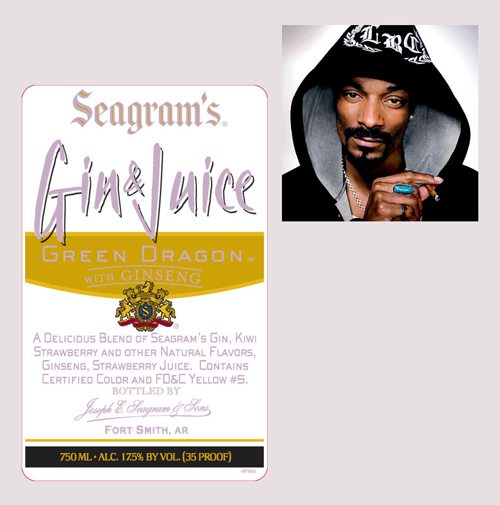Do you see something wrong with the above labels? All of them have “fancy” commodity statements, rather than one that is more stripped down. A plain commodity statement would be something like DISTILLED FROM GRAIN rather than DISTILLED FROM FRENCH WHEAT, as on the Grey Goose label above. On the one hand, there are many label approvals, such as the above. On the other hand, TTB recently rejected DISTILLED FROM NEW YORK GRAIN and said it must appear as DISTILLED FROM GRAIN instead. Can both the approvals and the rejection possibly be right? Between the two, what do you think is more right? This can be critical because most vodka and gin labels must have a compliant commodity statement, to show the commodity from which the base spirits are distilled. The examples above are Heart of the Hudson Vodka (NY Apples), Tuthilltown Vodka (75 pounds of Hudson Valley Apples), Grey Goose Vodka (French Wheat), Core Vodka (Hudson Valley Apples), Bootlegger Vodka (American Grain), and China Beach Vodka (California Grapes). Other examples are Cold River Gin (Maine Potatoes), Soft Tail Vodka (Washington State Apples), True North Vodka (Michigan Rye), and Flathead Vodka (Idaho Sugar Beets).
Continue Reading Leave a Commentgin
Gin & Juice & Music

Calvin knows a thing or two about the booze business. Not to mention all manner of other intoxicants. (I need to warm up to calling him by his assumed name.) Sixteen years ago Cordazar Calvin Broadus (aka Snoop Dogg) released a little song called “Gin & Juice.” It set off a big chain of events. It helped to launch his career, garnering a 1995 Grammy nomination. It also unleashed a slew of covers, such as this country version by The Gourds (it is slightly less obscene than the original, if only because it’s a little harder to make out the words). And most to the point, it also apparently unleashed the Gin & Juice product line as above. It’s possible that Seagram got there first, but I would tend to doubt it, based on not much more than the age of the song. The song specifically refers to the Seagram and Tanqueray brands of gin. There is a whole lot in the song to horrify right-thinking persons, such as flagrant disregard for women, drug laws, mom’s wishes. But even more pernicious is the nonchalance about drinking and driving. In the original video, Snoop doesn’t quite cruise down the boulevard while sipping his gin and juice, but he might as well, as he sits behind the wheel...
Continue Reading Leave a CommentTwo Products, 24 Flavors

Here are two recent spirits products with an unusal and unusually large assembly of flavors. On the following list, the first 13 flavors are on the Root label, and the next 11 are on the Pink Spruce label.
- Birch bark
- Smoked black tea
- Cinnamon
- Wintergreen
- Spearmint
- Clove
- Anise
- Orange
- Lemon
- Nutmeg
- Allspice
- Cardamom
- Pure cane sugar
- Spruce oil
- Cucumber
- Juniper berries
- Angelica root
- Orange peel
- Lemon peel
- Coriander
- Ginger
- Orris root
- Grains of paradise
- Tangerine oil
The Pink Spruce Gin label also mentions that the product is made with “free range coastal water,” it is “Seasoned in Oregon Pinot Barrels,” and distilled from grain. The Root product strangely does not mention the commodity from which distilled and probably should. It was “inspired by a potent 18th century… recipe. … It is an alcoholic version of what eventually evolved into Birch or Root Beer.” There is almost no overlap in the list of flavors from one to the other.
Continue Reading Leave a CommentPhony Controversy Du Jour

Maybe the world is not in such a sorry state after all, if there is room for outrage about a few beers named after exits on the New Jersey Turnpike. Various media report that MADD was alarmed about Flying Fish Brewing Company’s new Exit 4 beer, named after the nearest highway exit. Google already has well over 8,000 hits for this puny controversy. MADD is apparently concerned about linking driving with drinking, or condoning the same. But even the most cursory review shows that the link here, and the impropriety, are tenuous to put it mildly. Speaking of tenuous connections, it will be difficult for Flying Fish to find a connection between the unique aspects of 29 exits, and 29 distinctive beers. This is well evidenced by Exit 11, the second in the series; the connection is that both relate to … a confluence. Plenty of other labels highlight a highway or exit. Side Pocket Foods has about 10 Exit 172 labels. This Weibel wine celebrates Route 66, and this Oak Ridge wine pays homage to Route 88. And here is Route 3 Chardonnay. There is no reason for MADD to be alarmed about any of them.
Continue Reading Leave a CommentGreen Gin, Green Shiraz

Red Deer wine claims to be “Tree Free.” We could only guess that this means the labels are made from rice, or something other than trees. But no. The UPC label explains that the wine is “Untouched by oak – The ‘naturelle’ fruit characters of the wine are not overwhelmed by additives commonly introduced by man – LIKE OAK.” We are getting the impression they don’t like oak. The label says the producer is part of a sustainable resource initiative. It also refers to the “Intense body,” and TTB often disallows “intense” on table wines (where it suggests a high alcohol content). In other green beverages, Rainforest Gin claims it “Saves the Rain Forest with Every Bottle.” Of gin. Made in Cleveland.
Continue Reading Leave a CommentTags: organic/vegan/green, policy


